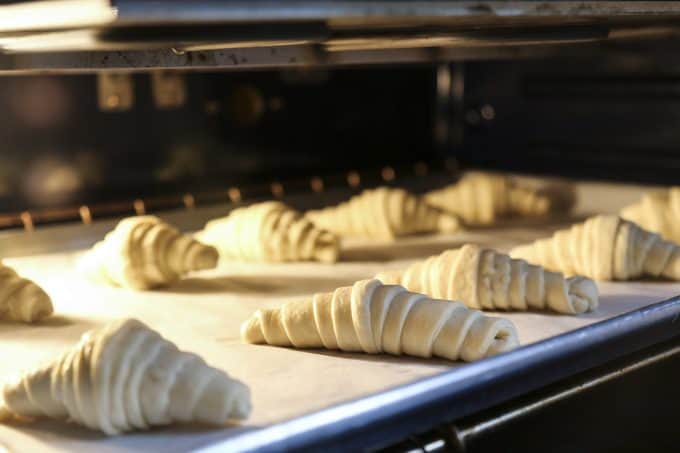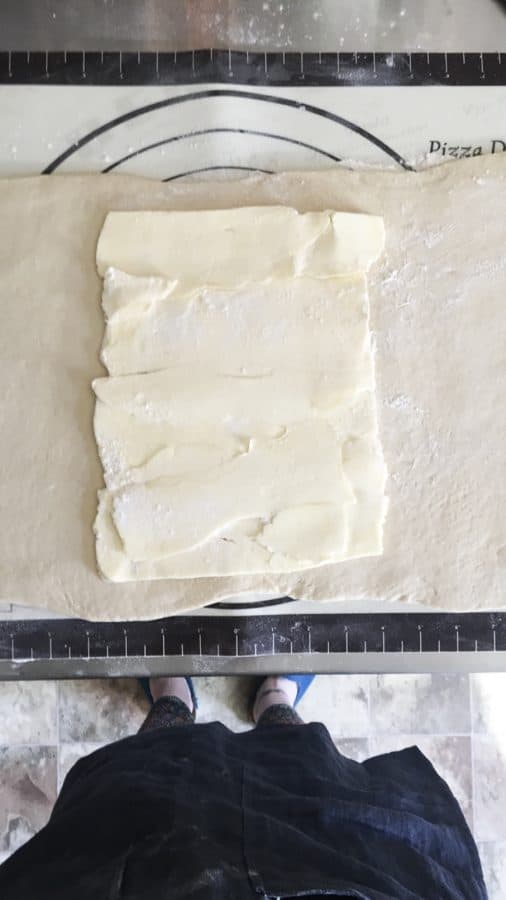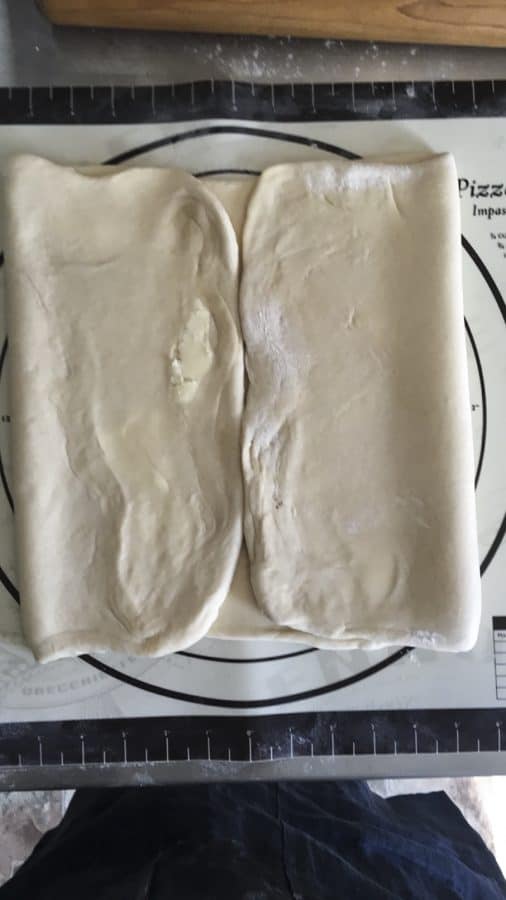So many of you have asked me to do a tutorial, and I’m so happy to break down How to Make Croissants for you. Between the video and the Cook’s Notes, you should be able to wow yourself and your friends and family with a bread basket full of flaky, buttery, deep brown croissants.
For more fantastic Bread Recipes, visit our special Homemade Bread page!
There is a mystique surrounding croissants. Everyone knows they’re flaky, buttery, and delicious, but few people venture into making croissants for themselves because they’ve got a reputation for being fussy and difficult.
I get it. Anything that requires a couple of days of planning before hand can sound off-putting and intimidating.
Here’s the thing, though; there is really nothing in the wonderful world of baking quite like a homemade croissant that you’ve just pulled out of your own oven. It is so worth it the work.
Many American bakeries have some sort of complex regarding blonde croissants. In their fear of overcooking the pastry, they end up with a poor, pale, under-cooked shadow of a piece of pastry that cannot compare to a mahogany coloured croissant with an exterior so flaky that it showers crumbs when you tear it apart or bite into it.
The soft chew of the many interior layers provides the contrast to that deep, dark, shatteringly toasted outer layer. It’s perfection when it’s done right.
…And doing it right isn’t hard when someone breaks down the steps for you. I’m here to help you out, folks.
Watch the video, and let me break it down for you here. I am here to show you how to make croissants!
I cannot think of something that makes a special occasion better than a basket full of homemade pastry. The dough used in our homemade croissants recipe is -quite handily- the same dough used in our classic and irresistible Pain Au Chocolates {Chocolate filled croissants or Chocolatines}.
It is also the dough used for a couple of forthcoming recipes here on Foodie with Family. Once you’ve mastered this dough -and I do promise it isn’t that hard even if it takes a bit of a time commitment- the world of pastries is yours to grab!
Normally, our Cook’s Notes come right before the recipe, but because today’s How to Make Croissants tutorial is a little lengthy, and these notes are important to help you through the process, I’m moving them up top. Be sure to keep them in mind as you move into making croissants.
Cook’s Notes
- There is NO substitute for butter. None. Nada. Negatory. Zip. Zilch. No shortening. No coconut oil. No tub margarine. I’ve heard it said that you can make this with vegan butter sticks, but I haven’t tried it, so I can’t possibly recommend it. We’re talking about traditional, from-scratch French pastry here, and the French? They love that butter.
- Speaking of butter -because there is a lot of it in today’s recipe- please don’t use salted butter. You want to control the amount of salt going into your homemade croissants, and you just plain can’t if you start with salted butter. Use unsalted butter. Trust me.
- Please note that you’ll be working with cold butter in every step of this recipe except the tail end of it where you let the prepared pastries sit at room temperature while the oven heats and then while baking. This is important. If it starts getting squishy, pop it back in the refrigerator for a few to firm back up slightly. You want it to be malleable but not soft.
- I like to roll my dough out on a silicone dough mat. This makes it easy to measure it (because most mats are marked with measurements) and move the dough if needed in addition to being less likely to cling to your dough and rip it.
- If your dough starts fighting you, don’t rip or stretch it. This will destroy those layers you’re working so hard to create. Instead, slide your dough onto something like a sheet pan and into the refrigerator to rest for 20 to 30 minutes. This will allow the gluten to relax and roll out more easily. This is another situation where that silicone dough mat comes in handy.
- Speaking of resting and relaxing your dough, I find that if I can make the dough right up to the point where you’d roll it out, shape it, and bake it at least 3 but up to 5 days before I plan on baking it/working with it, that it rolls out like a dream with no fight left in it whatsoever. If you can plan that far ahead of time I HIGHLY recommend doing so.
- As far as cutting the dough, I adore a pizza cutter for this job. It doesn’t cut through my silicone mat, it rolls right through without tearing the dough layers, and it makes short work of it. Second best in this case is a bench knife.
- Are you short on warm, draft-free places for your croissants to rise? I suggest using an oven (not heated) with the light on. That seems to provide just enough warmth. If you’re in a real hurry to get them to rise, you can place a cake pan with boiling water on the shelf below the croissants.
Here is a sample timeline of what it might look like to make Homemade Croissants in the shortest amount of time:
-
- 8am April 5th: make dough.
- 9:15am April 5th: refrigerate dough, form and refrigerate butter.
- 11:30am April 5th: Roll out dough, laminate butter into dough, roll out again, fold, refrigerate.
- 1:30pm April 5th: Roll out half of the dough, form croissants, let rise at room temperature.
- 2pm April 5th: bake the croissants.
- 3pm April 5th: EAT!
Here is a sample timeline of what it might look like to make Homemade Croissants in the longest amount of time possible:
-
- 8am April 5th: make dough.
- 9:15am Tuesday, April 5th: refrigerate dough, form and refrigerate butter.
- 9:15am April 6th: Roll out dough, laminate butter into dough, roll out again, fold, refrigerate.
- 9:15am April 13th: Roll out half of the dough, form croissants, let it rise at room temperature.
- 9:45 am April 13th: bake the croissants.
- 10am April 13th: EAT!
Are we ready to make croissants? Roll those sleeves up, and let’s do this. As long as you can follow instructions, you’ll be fine! Here are the four main steps to making croissants in detail:
How to Make Croissants Step 1: Make the Dough
Make the dough. This simple yeast dough is enriched with just a little bit of butter. I find that it is easiest to mix the softened butter in with the yeast, milk, sugar, and about half of the flour. That way, you can be certain the butter disperses evenly through the dough.
A stand mixer makes light work of the job, but you can go seriously old-school and do all of the mixing by hand if you so desire. Once you have a homogeneous mixture, add in the rest of the flour and mix until a dough forms that pulls away from the edges of the bowl.
If you’re using a stand-mixer, you can knead this dough with a dough hook. If you’re mixing by hand, you will turn the dough out on to a clean counter and knead until smooth and elastic.
Place the dough in a lightly greased bowl (or lightly grease the stand-mixer’s bowl and return the dough to that.) Cover with a clean tea towel and let rise for about an hour, or until puffy. If your room is cool, you may find this takes up to another hour longer.
Use cooking spray to spritz the inside of a gallon sized zipper top bag. Turn the dough out onto the counter, flatten it gently with the palms of your hands, and fold in thirds like a letter. Slide the dough into the prepared bag, zip the bag shut, and place into the refrigerator for at least 2 hours, but up to 24 hours.
How to Make Croissants Step 2: Prepare the Butter
While the dough is chilling, prepare your butter. This can be done as soon as you’ve placed the dough in the refrigerator, if you’d like.
Cut 2 half-cup sticks of butter in half lengthwise. This will give you four long rectangles of butter. Set aside.
Lay a 12-inch or longer piece of waxed paper or plastic wrap. Sprinkle thoroughly with flour.
Lay the sticks of butter side by side (touching), sprinkle with more flour, and lay another piece of waxed paper or plastic wrap over the top. Gently smack with a rolling pin until the butter becomes malleable, then roll it out until it is approximately 6-inches by 9-inches.
Wrap well with the waxed paper or plastic wrap with which you rolled it and return it to the refrigerator or at least an hour or until you’re ready to deal with the dough.
How to Make Croissants Step 3: Create the Pastry
Take the refrigerated dough from the bag and place onto your counter. Roll out until it forms a rectangle that is approximately 10-inches by 20-inches.
Take the refrigerated butter from its wrapper and center the butter on top of the dough. This will leave you with about 1/3 of the dough open, followed by 1/3 covered by butter, followed by another open 1/3 of dough.
Fold an open side of dough over the butter, then fold the other open side of dough over the previously folded side of dough, much like you’re folding a letter into thirds. Now that the dough is folded, pinch the edges together thoroughly, sealing the butter into the dough completely.
Roll the dough out into a 10-inch by 24-inch rectangle. This time, fold both ends in toward the center to meet in the middle, then fold that in half like closing a book. Wrap this up with floured plastic wrap and return the whole thing to the refrigerator for at least 2 hours but up to 7 days.
How to Make Croissants Step 4: Put it All Together and Bake
Remove the dough from the refrigerator, unwrap, cut in half, re-wrap half and return it to the refrigerator. Roll out the remaining half of the dough into a rectangle that is roughly 9-inches by 25-inches. Use a pizza cutter, bench knife, or sharp paring knife to trim the sides neatly to an 8-inch by 24-inch rectangle.
Working in a zig-zag pattern, cut the rectangle into 8 to 10 long triangles, depending on the size you want your finished croissants to be.
Working with one triangle at a time, gently grasp both of the corners of the base of the triangle. Gently pull to stretch slightly and begin to roll firmly but not tightly.
You want it to hold together but not be squished together. Continue to roll, tugging gently back on the already rolled portion to slightly stretch the slack that hasn’t been rolled yet.
Do this until you reach the point of the triangle. Stretch to wrap the tip around and gently press it into place.
Position this on a parchment lined pan with the tip resting on the pan. Do this with your remaining triangles, placing the rolled dough at least 3 inches apart on the pan to account for expansion in rising and baking.
Whisk together a large egg with a pinch of salt until even in colour. Brush the tops lightly with the egg wash.
Place in a warm, draft-free place to rise until the dough is puffy. Put the egg wash in the refrigerator to use again before baking.
Preheat the oven to 425F. Brush the tops of the croissants again with the egg wash.
Bake for 15 to 18 minutes, or until a the pastry is puffed, set, flaky, and caramelized to a deep rosewood brown. Let the pastries rest on the pan for 5 minutes before transferring to a cooling rack.
These are always best when eaten slightly warm on the day they were made, but if there is some weird circumstance in which they’re not all eaten immediately, I have loved them the day after they were made, too.
Connect with Foodie with Family
facebook | pinterest | instagram | twitter
How to Make Croissants at home? Use these items to make it easier!

How to Make Croissants
Rate RecipeIngredients
To Make the Dough:
- 1 1/2 cups whole milk
- 1/4 cup granulated sugar
- 4 1/2 cups all-purpose flour 1 pound 3 1/8 ounces, by weight
- 2 teaspoons instant or active yeast
- 2 teaspoons kosher salt
- 2 tablespoons unsalted butter softened
For the Butter:
- 2 sticks unsalted butter (1 cup by volume, 8 ounces by weight)
- all-purpose flour
Additional Ingredients:
- 1 large egg, whisked with 1 tablespoon of water
- 1 pinch kosher salt
Instructions
To Make the Dough:
- Mix the softened butter in with the yeast,salt, milk, sugar, and about half of the flour in the bowl of a stand mixer fitted with a batter blade. Once you have a homogenous mixture, add in the rest of the flour and mix until a dough forms that pulls away from the edges of the bowl. Lightly grease the stand-mixer's bowl, form a tight round of dough, return the dough to the bowl, and cover with a clean tea towel. Let rise for about an hour, or until puffy. If your room is cool, you may find this takes up to another hour longer.
- Use cooking spray to spritz the inside of a gallon sized zipper top bag. Turn the dough out onto the counter, flatten it gently with the palms of your hands, and fold in thirds like a letter. Slide the dough into the prepared bag, zip the bag shut, and place into the refrigerator for at least 2 hours, but up to 24 hours.
Prepare the Butter:
- While the dough is chilling, prepare your butter. This can be done as soon as you've placed the dough in the refrigerator, if you'd like. Cut 2 half-cup sticks of butter in half lengthwise. This will give you four long rectangles of butter. Set aside. Lay a 12-inch or longer piece of waxed paper or plastic wrap. Sprinkle thoroughly with flour. Lay the sticks of butter side by side (touching), sprinkle with more flour, and lay another piece of waxed paper or plastic wrap over the top. Gently smack with a rolling pin until the butter becomes malleable, then roll it out until it is approximately 6-inches by 9-inches. Wrap well with the waxed paper or plastic wrap with which you rolled it and return it to the refrigerator or at least an hour or until you're ready to deal with the dough.
Creating the Pastry:
- Take the refrigerated dough from the bag and place onto your counter. Roll out until it forms a rectangle that is approximately 10-inches by 20-inches. Take the refrigerated butter from its wrapper and center the butter on top of the dough. This will leave you with about 1/3 of the dough open, followed by 1/3 covered by butter, followed by another open 1/3 of dough. Fold an open side of dough over the butter, then fold the other open side of dough over the previously folded side of dough, much like you're folding a letter into thirds. Now that the dough is folded, pinch the edges together thoroughly, sealing the butter into the dough completely. Roll the dough out into a 10-inch by 24-inch rectangle. This time, fold both ends in toward the center to meet in the middle, then fold that in half like closing a book. Wrap this up with floured plastic wrap and return the whole thing to the refrigerator for at least 2 hours but up to 7 days.
Putting It All Together and Baking:
- Remove the dough from the refrigerator, unwrap, cut in half, re-wrap half and return it to the refrigerator. Roll out the remaining half of the dough into a rectangle that is roughly 9-inches by 25-inches. Use a pizza cutter, bench knife, or sharp paring knife to trim the sides neatly to an 8-inch by 24-inch rectangle. Working in a zig-zag pattern, cut the rectangle into 8 to 10 long triangles, depending on the size you want your finished croissants to be.
- Working with one triangle at a time, gently grasp both of the corners of the base of the triangle. Gently pull to stretch slightly and begin to roll firmly but not tightly. You want it to hold together but not be squished together. Continue to roll, tugging gently back on the already rolled portion to slightly stretch the slack that hasn't been rolled yet. Do this until you reach the point of the triangle.
Stretch to wrap the tip around and gently press it into place. Position this on a parchment lined pan with the tip resting on the pan. Do this with your remaining triangles, placing the rolled dough at least 3 inches apart on the pan to account for expansion in rising and baking. Whisk together a large egg with a pinch of salt until even in colour. Brush the tops lightly with the egg wash. Place in a warm, draft-free place to rise until the dough is puffy and slightly jiggly. Put the egg wash in the refrigerator to use again before baking. - Preheat the oven to 425F. Brush the tops of the croissant with the egg wash. Bake for 15 to 18 minutes, or until the pastry is puffed, set, flaky, and caramelized to a deep rosewood brown. Let the pastries rest on the pan for 5 minutes before transferring to a cooling rack. These are always best when eaten slightly warm on the day they were made, but if there is some weird circumstance in which they're not all eaten immediately, I have loved them the day after they were made, too.
Nutrition
Nutritional information is an estimate and provided to you as a courtesy. You should calculate the nutritional information with the actual ingredients used in your recipe using your preferred nutrition calculator.
did you make this recipe?
Make sure to tag @foodiewithfam on Instagram and #hashtag it #foodiewithfamily so I can check it out!











Reader's Thoughts...
1 star giver says
i did not ask your life story in this recepie
Rebecca says
And I didn’t ask for you to misspell recipe, but here we are. I bet you’re a delight at parties.
Shaheena says
It’s an amazing recipe. The croissants turned out to be buttery, light and flaky. Yummy. Thanks for the recipe. 🤗
Rebecca says
You’re very welcome, Shaheena! Thanks so much for letting me know you love it.
Janelle says
Can I use oat milk instead of whole milk?
bonita says
i am so much going to try this as this is something i have wanted to learn how to do but do you have a recipe for almond croissants or could i just put almond paste inside of these
Rebecca says
Hi Bonita- I do not yet have an almond croissant recipe, but you make me think I should work on one! I’ll definitely post it when I’ve made it!
Sherry says
I’ve Tried to repeat croissants making since my cooking class In France. The recipe given was in weight, grams ect, It didn’t work out for me here in Cali. I about love croissants and can no longer eat the store bought ones….homemade are soooo much better. Thank you for recipe and demo video
Dawn says
Hi there, my 13-year old is giving this a go. We noticed that the recipe says to put half of the dough in the refrigerator before the final cutting and rolling. But we can’t find what happens to that second half. Are you just doing a second batch and keeping the dough cool in the meantime? Or do you put the second half away for another time? Freeze it? Just curious. I think we’re thinking to make half croissants and half pain au chocolat so that’s probably what we’ll do if we don’t hear back. Thank you!
Rebecca says
Hi Dawn- I’m sorry that I didn’t explain that clearly. 🙂 Yes, it means the second half is in the refrigerator for another batch of pain au chocolat or croissants or ham and cheese croissants (my personal fave)…
Laura says
I made these with a can of coconut milk and coconut oil instead of egg wash (still used real butter) and they turned out wonderfully! Thanks for making it so easy to follow!
Rebecca says
You’re very welcome, Laura! I’m glad you loved them!
Emily says
For the first dough making step, can I use a bread machine?
Rebecca says
Sure, if you really want to, but I prefer using my stand mixer for the job. 😉
Kelly Palazzolo says
I stumbled upon this recipe last week after looking up recipes for ham and cheese croissants. A local store makes them but they are pricey. Your directions are so clear that I made my first batch last weekend. We had fresh made croissants on Thursday, and I’m making the ham and cheese version for dinner this evening. We are a family of just 2…my 12 year old son and I… so we will just pretend that I never admitted that we ate the first half batch in one day. They were delicious and the ONLY issue I had was completely my fault from not trusting my Kitchen Aid to knead the dough properly.. and then not kneading it long enough by hand. I’ve been browsing your site since and will be making many more of your dishes (and scented gels…even with one boy.. well… you know how they are). I’m so happy I stumbled onto your site – and my son is thrilled with mom making croissants. He starts taking french classes next year and one summer goal is to teach him to make these as well. Whew! that was a long winded thanks for an awesome recipe and instructions.. croissants are not intimidating anymore 🙂
Rebecca says
Thank you so much, Kelly! I’m so glad you had such a great experience. And please tell your son bonne chance!
Louise says
Will it work ok using almond milk? I’m not looking for dairy free. Just prefer almond milk over cow’s milk.
Rebecca says
Hi Louise- I’m not sure it would work, not having tried it. As someone else who doesn’t drink cow’s milk, I can unhesitatingly tell you that I still use it in this recipe because both the fat and viscosity work well for it. I would be hesitant to substitute almond milk.
Confused says
Where does the salt come in? I have read the recipe as well as the post and there is no mention of adding the salt.
Rebecca says
Hi there… I must have backspaced through salt in the instructions. I’ve fixed it. 🙂
Catherin says
Hi… this recipe mentions water but there is no quantity given. I just made the dough without any water and it seems a bit tight so just wondering if water should have been added.
Rebecca says
Hello there, Catherin-
Thanks for asking that question! For some reason, in the body of the post I wrote it as water, but I use whole milk in the recipe. My apologies for any confusion; it’s been fixed!
David Alonzo says
I LOVE a good Croissant. Always searching for them locally. Have been disappointed many times when bakery croissants look better than they taste. So I’m willing to try to make my own. However, I live in Colorado at an altitude of 7600 feet, so my question is this : Are you aware of any changes to your recipe needed when baking these at HIGH ALTITUDE? Thanks. David
Rebecca says
Hi David- I’m sorry to admit that I know next to nothing about baking at high altitude. Please do come back and let me know how it worked where you are and if you made any changes!
Rebecca says
Oh! And if you’re looking for a great resource on baking at high altitude, could I refer you to my friend, Kelley of Mountain Mama Cooks?